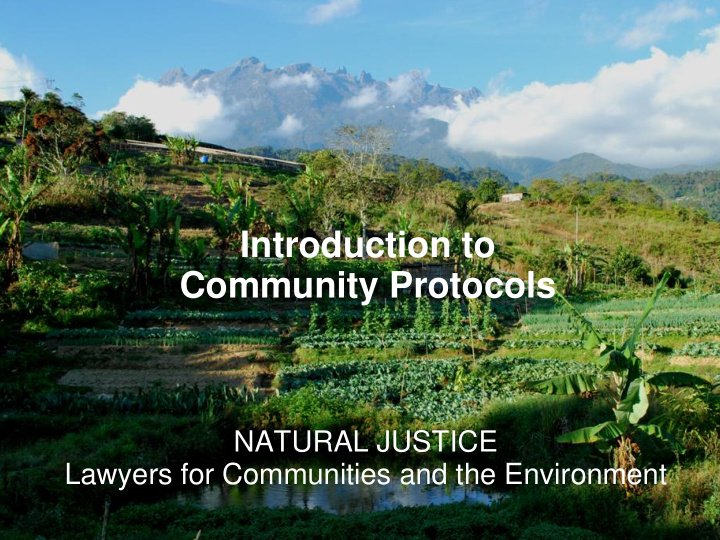



Introduction to Community Protocols NATURAL JUSTICE Lawyers for Communities and the Environment
BIOLOGICAL AND CULTURAL DIVERSITY
LEGAL CHALLENGES TO BIOLOGICAL AND CULTURAL DIVERSITY Fragmentation of landscapes (cultural and 1. natural) Definition of “community”, “prior informed 2. consent”, “competent authority”, etc. Interactions and potential conflicts between 3. customary and positive law
WHAT ARE COMMUNITY PROTOCOLS? Generally, a community protocol sets out the community‟s • terms and conditions about how outside agencies can/should/have to engage with them, according to different laws These often include procedures for free, prior and informed • consent, access to information, and participation in decision- making Often focus on substantive rights and responsibilities such • as to self-determination and self-governance, customary ownership over resources, areas and territories, ways of life There are many different local manifestations… no “template” • or “best practice” (but there may be “good practice” or core principles)
WHAT ARE COMMUNITY PROTOCOLS? • Interface between different legal systems and understandings of rights and responsibilities • Supports dialogue and constructive collaboration between different rights-holders and duty-bearers – both aspirational and „defensive‟ • Supports communities to take ownership over the law and decision-making processes that impact their ways of life • Helps provide clarity and legal certainty to governments, researchers, and other actors
COMMUNITY PROTOCOLS Through community dialogue processes, protocols often set out, inter alia : Who the community is Community relationships with land Local values, priorities, and visions Local processes and terms & conditions for accessing, using, and sharing resources Local challenges and opportunities Rights under customary, national, and international law Calls to other rights-holders and duty-bearers to respect customary laws relating to actions on territories and to take positive actions where requested
EXAMPLES Potato Park benefit-sharing agreement amongst Quechua communities Kuna community protocol on traditional knowledge and customary ways of life Raika community protocol on livestock keepers‟ rights and animal genetic resources Bushbuckridge Traditional Healers‟ Association biocultural community protocol on traditional medicinal knowledge and access to medicinal plants Sirkhazi Organic Farmers‟ Association community protocol on customary organic farming practices and traditional rice varieties … and many more!
RELEVANCE IN NAGOYA PROTOCOL Preamble Noting UNDRIP; inseparable interrelationship between traditional knowledge and genetic resources; obligation to not restrict customary use and exchange, etc. Article 6(2): Access to genetic resources (“established rights”) Article 7: Access to traditional knowledge Article 11: Transboundary cooperation Article 12: Traditional knowledge associated with genetic resources Parties shall take into consideration customary laws and community protocols and procedures Parties shall support the development by Indigenous [peoples] and local communities, particularly women, of community protocols, etc. Parties shall not restrict customary use and exchange Article 13: Competent national authorities Article 21: Awareness raising … and more!
CAVEATS & CHALLENGES • Community protocols are not necessarily appropriate for every situation or community • There is potential for the process to be co-opted by NGOs, government, or local elites - inequities could be further entrenched • How to ensure representation of different community voices, particularly marginalized ones? • One community‟s protocol should not interfere with or undermine other communities‟ rights, values, or endogenous development plans • Potential for standardization of something that is inherently diverse. What are the pros and cons of developing guidelines or working towards legal recognition of community protocols?
SUMMARY Indigenous peoples and local communities are using protocols to communicate in their own voices how their ways of life are helping conserve and sustainably use ecosystems and why they should be supported in continuing to do so Community protocols are one of many adaptive tools that communities can use to ensure that legal frameworks and mechanisms such as access and benefit sharing are undertaken are according to their rights, values, and local priorities Community protocols help clarify rights and responsibilities, provide legal certainty to governments, researchers, and other actors, and support the conservation and sustainable use of biodiversity
Thank you! NATURAL JUSTICE: Lawyers for Communities and the Environment Holly Shrumm holly@naturaljustice.org www.naturaljustice.org www.natural-justice.blogspot.com www.facebook.com/naturaljustice
Recommend
More recommend